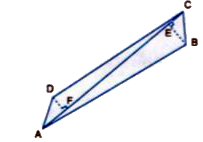Find the area of a quadrilateral one of whose diagonals is 30 cm long and the perpendiculars from the other two vertices are 19 cm and 11 cm respectively.
The correct Answer is:450 cm2
To find the area of the quadrilateral with the given dimensions, we can follow these steps:
1. Identify the Given Values:
- Length of diagonal (d) = 30 cm
- Perpendicular from one vertex (h1) = 19 cm
- Perpendicular from the other vertex (h2) = 11 cm
2. Use the Area Formula for a Quadrilateral:
The area (A) of a quadrilateral when one diagonal and the perpendiculars from the opposite vertices are known can be calculated using the formula:
A=12×d×(h1+h2)
3. Substitute the Values into the Formula:
Substitute the values of d, h1, and h2 into the formula:
A=12×30×(19+11)
4. Calculate the Sum of the Perpendiculars:
Calculate h1+h2:
19+11=30
5. Substitute the Sum Back into the Area Formula:
Now substitute this sum back into the area formula:
A=12×30×30
6. Perform the Multiplication:
Calculate 30×30:
30×30=900
7. Calculate the Final Area:
Now calculate 12×900:
A=9002=450 cm2
Final Answer:
The area of the quadrilateral is 450 cm2.
---
- Length of diagonal (d) = 30 cm
- Perpendicular from one vertex (h1) = 19 cm
- Perpendicular from the other vertex (h2) = 11 cm
The area (A) of a quadrilateral when one diagonal and the perpendiculars from the opposite vertices are known can be calculated using the formula:
A=12×d×(h1+h2)
Substitute the values of d, h1, and h2 into the formula:
A=12×30×(19+11)
Calculate h1+h2:
19+11=30
Now substitute this sum back into the area formula:
A=12×30×30
Calculate 30×30:
30×30=900
Now calculate 12×900:
A=9002=450 cm2
The area of the quadrilateral is 450 cm2.
Topper's Solved these Questions
- AREA AND PERIMETER OF PLANE FIGURESBOOK - ICSECHAPTER - AREA AND PERIMETER OF PLANE FIGURESEXERCISE - EXERCISE 20(C)
27 Videos
- AREA AND PERIMETER OF PLANE FIGURESBOOK - ICSECHAPTER - AREA AND PERIMETER OF PLANE FIGURESEXERCISE - EXERCISE 20(D)
12 Videos
- AREA AND PERIMETER OF PLANE FIGURESBOOK - ICSECHAPTER - AREA AND PERIMETER OF PLANE FIGURESEXERCISE - EXERCISE 20(A)
18 Videos
- AREA THEOREMSBOOK - ICSECHAPTER - AREA THEOREMSEXERCISE - Exercies 16(C )
22 Videos
Similar Questions
Find the area of a quadrilateral one of whose diagonal, is 25 cm long and the perpendicular from the other two vertices to this diagonal are 10 cm and 12 cm.
View SolutionFind the area of a quadrilateral which has one diagonal measuring 22 cm, and the perpendiculars from the opposite vertices on this diagonal are 6 cm and 10 cm, respectively.
View SolutionFind the area of a quadrilateral ABCD whose diagonal AC is 25 cm long and the lengths of perpendiculars from opposite vertices B and D on AC are BE = 3.6 cm and DF = 2.4 cm .

View SolutionOne diagonal of a quadrilateral is 20 m long and the perpendiculars to it from the opposite vertices are 8.5 m and 11 m. Find the areaof the quadrilateral.
View SolutionThe ara of a quadrilateral is 780 sq. cm One of its diagonals measures 30 cm. If the perpendicular from one of the oppsite vertices on this diagonal is 15 cm, find the length of the perpendicular on this diagonal from the other vertex.
View SolutionFind the perimeter of a rhombus whose diagonals are 30 cm and 34 cm.
View SolutionFind the perimeter of a rhombus whose diagonals are 30 cm and 40 cm.
View SolutionFind the area of a triangle whose sides are 17 cm, 8 cm and 15 cm long.
View SolutionFind the area of the rhombus , the lengths of whose diagonals are 17.5 cm and 22.4 cm.
View SolutionFind the area of a triangle whose sides are 3cm, 4cm and 5cm respectively.
View Solution
